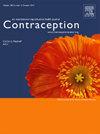在乌干达和尼日利亚验证注重避孕偏好的生育管理指数。
IF 2.3
2区 医学
Q1 OBSTETRICS & GYNECOLOGY
引用次数: 0
摘要
研究目的在尼日利亚和乌干达评估以避孕为重点的 "偏好调整生育管理"(PFM)指数的构建有效性:研究设计:我们分析了来自乌干达新避孕药具使用者和非避孕药具使用者以及尼日利亚避孕药具使用者便利样本的调查数据。PFM 指数得分由两个指标综合计算得出:指标 1 评估使用避孕药具的愿望与实际使用之间的一致性;指标 2 评估使用者目前使用的避孕方法是否符合愿望。我们建立了一个相关结构的提名网络,并进行了双变量逻辑回归,预测与每个变量相关的 PFM 的几率:结果:尼日利亚 71.3% 的避孕药具使用者、乌干达 99.2% 的新使用者和乌干达 42.9% 的非使用者都采取了注重避孕的计划生育措施。在尼日利亚,妇女和女孩在性健康和生殖健康方面的赋权指数得分高以及获准前往保健中心就诊与注重避孕的 PFM 的高几率显著相关(OR=2.72;95%CI=1.01-7.31;OR=2.64;95%CI=1.04-6.73)。在乌干达,妇女和伴侣的中学教育程度与注重避孕的 PFM 的较高几率显著相关(OR=2.58;95%CI=1.58-4.24,2.01;95%CI=1.54-2.62,分别为 2.58;95%CI=1.58-4.24,2.01;95%CI=1.54-2.62)。分别为1.48;95%CI=1.30-1.69,OR=2.33;95%CI=1.52-3.56,OR=4.44;95%CI=2.77-7.12):以避孕为重点的 PFM 指数在尼日利亚和乌干达显示出了构建有效性。PFM 及其他新的自我界定需求衡量标准有助于实现模式转变,使避孕指标与人权原则保持一致。本文章由计算机程序翻译,如有差异,请以英文原文为准。
Validation of the contraception-focused Preference-aligned Fertility Management Index in Uganda and Nigeria
Objectives
This study aimed to evaluate construct validity of the contraception-focused “Preference-aligned Fertility Management” (PFM) Index, a new person-centered and rights-based outcome measure, in Nigeria and Uganda.
Study design
We analyzed survey data from convenience samples of new users of contraception and nonusers of contraception in Uganda and users of contraception in Nigeria. PFM Index scores were calculated by combining two indicators: indicator 1 assessing alignment between desire to use contraception and actual use; indicator 2 evaluating whether users’ current methods are desired. We developed a nomological network of related constructs and conducted bivariable logistic regressions, predicting the odds of PFM associated with each variable.
Results
A total of 71.3% of contraception users in Nigeria, 99.2% of new users in Uganda, and 42.9% of nonusers in Uganda were practicing contraception-focused PFM. In Nigeria, high Women’s and Girls’ Empowerment in Sexual and Reproductive Health Index scores and permission to visit a health center were significantly associated with higher odds of contraception-focused PFM (odds ratio [OR] = 2.72; 95% CI = 1.01–7.31; OR = 2.64; 95% CI = 1.04–6.73, respectively). In Uganda, women’s and partner’s secondary school education were significantly associated with higher odds of contraception-focused PFM (OR = 2.58, 95% CI = 1.58–4.24; OR = 2.01; 95% CI = 1.54–2.62, respectively); as were concordance with partner’s desired number of children, recent experience of gender-based violence, and satisfaction with what (if anything) one is doing to prevent pregnancy (OR = 1.48, 95% CI = 1.30–1.69; OR = 2.33; 95% CI = 1.52–3.56; OR = 4.44, 95% CI = 2.77–7.12, respectively).
Conclusions
The contraception-focused PFM Index demonstrated construct validity in Nigeria and Uganda. PFM and other new measures of self-defined need contribute to the paradigm shift underway to align contraception indicators with human rights principles.
Implications
The contraception-focused PFM Index is a novel person-centered, rights-based measure that can be used to gauge whether individuals’ self-defined needs related to contraception are met by programs and policies. Our study finds evidence for construct validity of the index among contraceptive users in Nigeria and Uganda and nonusers in Uganda.
求助全文
通过发布文献求助,成功后即可免费获取论文全文。
去求助
来源期刊

Contraception
医学-妇产科学
CiteScore
4.70
自引率
17.20%
发文量
211
审稿时长
69 days
期刊介绍:
Contraception has an open access mirror journal Contraception: X, sharing the same aims and scope, editorial team, submission system and rigorous peer review.
The journal Contraception wishes to advance reproductive health through the rapid publication of the best and most interesting new scholarship regarding contraception and related fields such as abortion. The journal welcomes manuscripts from investigators working in the laboratory, clinical and social sciences, as well as public health and health professions education.
 求助内容:
求助内容: 应助结果提醒方式:
应助结果提醒方式:


